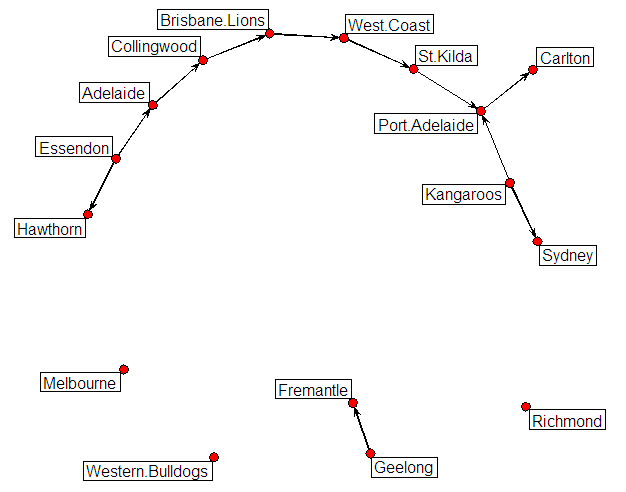The Other AFL Draft
/Drafting is a tactic well-known to cyclists and motor-racers and confers an advantage on the drafter by reducing the effort that he or she (or his or her vehicle) needs to expend in order to move.
There's a similar concept in round-robin sports where it's called the carry-over effect, which relates to the effect on a team's performance in a particular game that's due to the team its current opponent played in the previous round. Often, for example, it's considered advantageous to play teams the week after they've faced a difficult opponent, the rationale being that they'll have been 'softened up', demoralised and generally made to feel blah by the previous match.
The carry-over, or drafting, effects of the 2010 AFL draw are summarised in the following table:
You'll see there's a 1 in the row for Collingwood under the column headed "Ade" (for Adelaide). That 1 means that in only 1 of the 22 rounds does Collingwood play a team in the round immediately following the round in which they played Adelaide. This happens in Round 10 when Collingwood meets the Lions after the Lions played Adelaide in Round 9. So, Collingwood drafts Adelaide in Round 10.
Other numbers in the table are interpreted in the same way and the most interesting ones are those that are small (ie the zeroes) and those that are large (ie the 4s and the 5s). The zeroes make up a little less than 24% of the numbers in the table, and the 4s and 5s combined make up a bit less than 5%.
Looking at the row for a particular team you can determine which other teams that team most often drafts.
Only two teams draft another team on 5 occasions during the season: Essendon draft Adelaide, and Adelaide draft Collingwood. Seven teams draft another on 4 occasions: the Lions draft West Coast, Collingwood drafts the Lions, Essendon drafts Hawthorn, Geelong drafts Fremantle, the Roos draft Port and Sydney, Port drafts Carlton, St Kilda drafts Port, and West Coast draft St Kilda. In words that's quite a bit to take in - so here's a "directed graph" instead.
(The arrows point from the team drafted and to the team being drafted. Only drafts of 4 or more games are shown - that is, the ones mentioned in the earlier paragraph.)
From this chart we can see that, if we consider drafting to take place only if it involves one team following another for at least 4 games then:
- Port Adelaide is the only team to be drafted by more than one team (it's drafted by the Roos and St Kilda)
- Four teams - Hawthorn, Carlton, Sydney and Fremantle - are drafted but never themselves draft
- Three teams - Essendon, Geelong and the Roos - draft but are not themselves drafted
- Three teams - Melbourne, the Bulldogs and Richmond - are what graph theory would term "isolates" in that they neither draft nor are drafted
- The remaining six teams both draft and are drafted
- No pair of teams both draft one another and are drafted by one another
Make of all this what you will. At some point I might look to reproduce the analysis performed on Belgian football in this paper, which found that drafting mattered not in that competition, but for now, that's surely enough graph theory for one blog.



